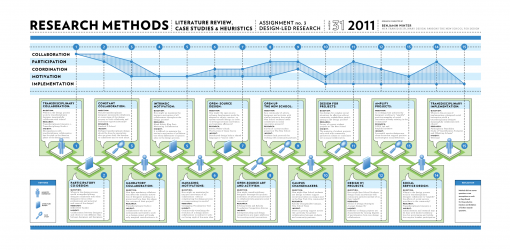Questionable Methods
Posted on April 7, 2011 | posted by:In our research methods course, there has been a lot of talk about the distinction between design-led research and research-led design. This dichotomy has become a major frame of reference for me recently and a constant refrain for me in class discussions. Thinking about design not only as a creative practice that solves problems but also as a reflective practice that generates distinct forms of knowledge—this is an idea I love.
So, when it came time to begin thinking about the approach I would take to our mid-term research methods project, to me the choice seemed clear. I had done plenty of research-led design in the past. I had always assumed that case studies, literature reviews, and ethnographic research were necessary precursors to every well-informed design project I did. But I was determined that this time around would be different. This time I would “think with my hands” and “learn by doing.”
Intent on employing design-led research methods, I embarked on David Gray’s “action research” cycle, ready to “plan, act, observe, and reflect.” I had a sense that I wanted to research transdisciplinary collaboration by designing a cultural probe to be used by my colleagues. I had begun framing some initial questions that I was interested in exploring with this approach, and now all I had to do was “plan” how to execute my designs.
From past studio experience, I already had some ideas about the different participants, motivations, and phases necessary for effective transdisciplinary collaboration. In designing the cultural probe I would use to explore these ideas further, I surveyed literature on human-centered and co-design processes, open-source software development, and the effects of intrinsic versus extrinsic motivation. I also looked at case studies and my own heuristic experiences for examples of the type of collaboration I wanted to prototype.
I was actually getting pretty excited about the designs I had planned—that is until I realized that they had once again been preceded by research! I was practicing research-led design all over again! What felt like the “plan” of my research cycle had turned into its primary “act,” and with every newly informed iteration of my research question I was in fact completing the whole cycle of planning, acting, observing, and reflecting—over and over again.
I was a little disappointed in myself for not breaking my habit of research-led design but not enough to hamper my excitement about the insights I had generated nonetheless. True, I was conducting another literature review and making observations before beginning to design, but I was learning some interesting things, so I decided to continue pursuing the same methods with a new attention to the sort of knowledge being produced.
Ultimately, the research methods I employed did not answer my questions so much as they broadened, deepened, and advanced them. These methods are particularly useful in situating ideas within the context of previous thought or prevailing knowledge and can also be used to support arguments or develop theories. However, to test ideas about collaboration or generate insights about largely undefined fields like transdisciplinary design, I suspect that the wise practitioner would do best to make something. Luckily, I get another chance to do just that.
